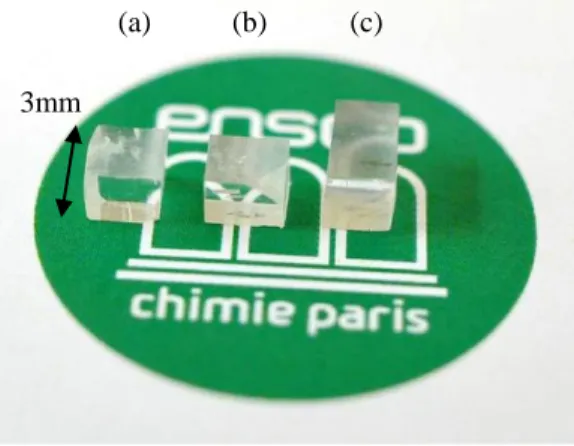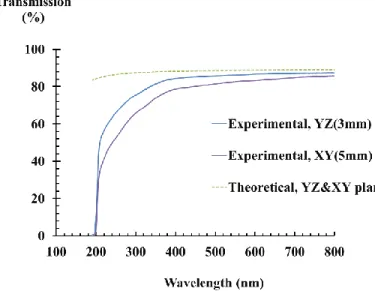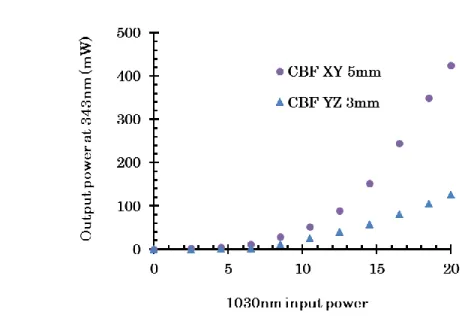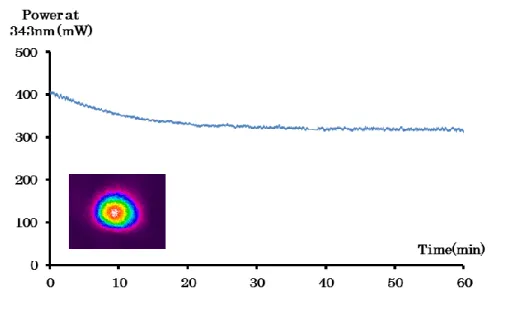HAL Id: hal-00934477
https://hal.archives-ouvertes.fr/hal-00934477
Submitted on 22 Jan 2014
HAL is a multi-disciplinary open access
archive for the deposit and dissemination of
sci-entific research documents, whether they are
pub-lished or not. The documents may come from
teaching and research institutions in France or
abroad, or from public or private research centers.
L’archive ouverte pluridisciplinaire HAL, est
destinée au dépôt et à la diffusion de documents
scientifiques de niveau recherche, publiés ou non,
émanant des établissements d’enseignement et de
recherche français ou étrangers, des laboratoires
publics ou privés.
Third harmonic generation at 343nm in nonlinear
Ca5(BO3)3F (CBF) crystals
Loïc Deyra, Simon Ilas, Xavier Délen, Pascal Loiseau, François Balembois,
Gérard Aka, François Salin, Patrick Georges
To cite this version:
Loïc Deyra, Simon Ilas, Xavier Délen, Pascal Loiseau, François Balembois, et al.. Third harmonic
generation at 343nm in nonlinear Ca5(BO3)3F (CBF) crystals. Optics Express, Optical Society of
America - OSA Publishing, 2013, 3 (11), pp.1798-1802. �10.1364/OME.3.001798�. �hal-00934477�
Third harmonic generation at
343nm in nonlinear Ca
5
(BO
3
)
3
F
(CBF) crystals
Loïc Deyra*1, Simon Ilas2, Xavier Délen1, Pascal Loiseau2, François Balembois1, Gerard Aka2, François Salin3, Patrick Georges1
1. Laboratoire Charles Fabry, Institut d’Optique, CNRS, Univ Paris-Sud, 91127 Palaiseau, France
2. Laboratoire de la Chimie de la Matière Condensée de Paris, CNRS-UMR 7574, ENSCP, 11 rue Pierre et Marie Curie, Paris,France
3. Eolite Systems, 11 avenue Canteranne, Pessac 33600, France
*Corresponding author : loic.deyra@institutoptique.fr
Abstract: We demonstrate for the first time UV generation at 343 nm by
frequency-tripling in the new non-hygroscopic Ca5(BO3)3F crystal. A boule of
CBF crystal was grown and cut along the two possible phase matching configurations for third harmonic generation in plans XY and YZ. 300 mW of UV average power have been obtained with a deff estimated at 0.45 pm/V for the
XY plan and 0.38 pm/V for the YZ plan.
2010 Optical Society of America
OCIS codes: (000.0000) General; (000.2700) General science.
References and links
1. V. P. Gapontsev, V. a Tyrtyshnyy, O. I. Vershinin, B. L. Davydov, and D. a Oulianov, “Third harmonic frequency generation by Type-I critically phase-matched LiB3O5 crystal by means of optically active quartz crystal.,” Optics express, vol. 21, no. 3, pp. 3715–20, Feb. 2013.
2. H. Hong, Q. Liu, L. Huang, and M. Gong, “Improvement and formation of UV-induced damage on LBO crystal surface during long-term high-power third-harmonic generation,” Optics Express, vol. 21, no. 6, p. 7285, Mar. 2013.
3. N. La, O. Bo, J. Zhang, L. Wang, Y. Li, G. Wang, and G. Zhang, “355nm laser generation based on NLBO crystal,” Optics Express, vol. 20, no. 15, pp. 16490–16493, 2012.
4. Y. Zhou, G. Wang, Y. Yue, C. Li, Y. Lu, and D. Cui, “High-efficiency 355 nm generation in barium aluminum borate diflouride (BaAlBO 3 F 2),” Optics letters, vol. 34, no. 6, pp. 746–748, 2009. 5. L. R. Wang, Y. Wu, G. L. Wang, J. X. Zhang, Y. C. Wu, and C. T. Chen, “31.6-W, 355-nm generation
with La2CaB10O19 crystals,” Applied Physics B, vol. 108, no. 2, pp. 307–311, May 2012.
6. Q. Liu, X. Yan, M. Gong, H. Liu, G. Zhang, and N. Ye, “High-power 266 nm ultraviolet generation in yttrium aluminum borate.,” Optics letters, vol. 36, no. 14, pp. 2653–5, Jul. 2011.
7. H. Liu, X. Chen, L. X. Huang, X. Xu, G. Zhang, and N. Ye, “Growth and optical properties of UV transparent YAB crystals,” Materials Research Innovations, vol. 15, no. 2, pp. 140–144, Apr. 2011. 8. K. Xu, P. Loiseau, G. Aka, R. Maillard, A. Maillard, and T. Taira, “Nonlinear optical properties of
Ca5(BO3)3F crystal,” Optics Express, vol. 16, no. 22, 2008.
9. M. J. Xia and R. K. Li, “Structure and optical properties of a noncentrosymmetric borate RbSr4(BO3)3,” Journal of Solid State Chemistry, vol. 197, pp. 366–369, Jan. 2013.
10. X. Délen, L. Deyra, A. Benoit, M. Hanna, F. Balembois, B. Cocquelin, D. Sangla, F. Salin, J. Didierjean, and P. Georges, “Hybrid master oscillator power amplifier nanosecond laser source at 257 nm,” Optics Letters, vol. 38, no. 6, pp. 995–997, 2013.
11. A. V. Smith, “Computer code SNLO(available from the authors at no charge).” 1997.
12. Z. Liao and S. Payne, “Thermally induced dephasing in periodically poled KTiOPO4 nonlinear crystals,” in Nonlinear Optics, 2004, pp. 2–6.
1. Introduction
Ultraviolet lasers are extensively used in the industry for material processing. Solid-state lasers have replaced gas lasers as reliable UV sources, thanks to the progress in the nonlinear crystals used for frequency conversions from infrared to ultraviolet. The most used nonlinear crystal for third harmonic generation (THG) is LiB3O5 (LBO), which has demonstrated conversion efficiencies from infrared to UV up to 40% [1]. While its optical properties and crystal qualities are excellent, it still suffers from hygroscopic issues that hinder its long-term operation potential [2]. For this reason, other crystals from the borate family have shown growing interest thanks to their non-hygroscopic nature. In 2012, a power of 3 mW of 355 nm laser radiation was demonstrated using the non-hygroscopic Na3La9O3(BO3)8 (NLBO) crystal, but the crystal was damaged in the process[3].In 2009, 0.6 mW were demonstrated in a BaAlBO3F2 (BABF) crystal[4]. La2CaB10O19 (LCB) crystals only operate in type-I third harmonic generation and have less interesting optical properties than LBO, but they can be grown in large dimensions and have recently shown high conversion efficiencies in the UV[5]. YAl3(BO3)4 crystals have shown very interesting properties for UV generation[6], but the growth of large and transparent UV crystals is still a subject under investigation[7].
One other promising crystal that has been developed is the member of the fluoborate family Ca5(BO3)3F (CBF), which is chemically stable (non-hygroscopic). While its frequency doubling properties have already been determined [8], no previous experimental studies had been made about its third harmonic properties.
2. Crystal characterization
CBF is a biaxial nonlinear crystal belonging to the fluoborate family. It crystallizes in the acentic space group Cm (Z=2)[8], and be grown by flux method, using LiF as a flux. The nonlinear properties of CBF were calculated in previous work based on the refractive index measurement [8], and are displayed in Table 1 compared to classical third harmonic crystals such as LBO and BBO. We chose to display only type-II third harmonic generators because this configuration is easier to implement thanks to the appropriate state of polarization at the end of the SHG crystal. We can see that CBF has nonlinear properties comparable to LBO in terms of walk-off and acceptance angle. In the previous study on CBF, the nonlinear susceptibility deff was measured only for second harmonic generation from 1064 nm to 532 nm. The deff values for third harmonic generation inset in Table 1 are determined below in this study.
Table 1: nonlinear properties of CBF compared to commercial type-II THG crystals (* deduced from this study)
A CBF crystal with a large size (diameter = 17 mm and length = 35 mm) has been obtained by using 20wt% LiF as flux in air. The CBF boule was cut in two different planes corresponding to the two possible type-II THG phase matching directions. Two crystals of dimensions 3x3x3 mm3 were cut in the YZ plane, with θ=57.7° and φ=90°. Then, a third crystal of dimension 3x3x5 mm3 was cut in the XY plane with θ=90° and φ=72.6°. The 3 crystals picture is displayed in Figure 1. The theoretical nonlinearities can be calculated from the following formulas:
𝑑
𝑒𝑓𝑓 𝐼𝐼𝑋𝑌= 𝑑
31𝑠𝑖𝑛
2𝜑 + 𝑑
32𝑐𝑜𝑠²𝜑
(1)
𝑑
𝑒𝑓𝑓 𝐼𝐼𝑌𝑍= 𝑑
31
𝑠𝑖𝑛𝜃
(2)
By using d31=0.49 pm/V and d32=-0.53 pm/V [9], the theoretical nonlinearities of CBF for THG of 1030nm are dXY
eff II=0.41 pm/V and dYZeff II=0.45 pm/V.
Crystal CBF XY CBF YZ LBO BBO
deff (pm/V) 0.45* 0.38* 0.465 1.24
Angular acceptance (mrad.cm) 1.6 3.8 3.45 0.37
Walk-off (mrad) 18.4 8.4 9 80
Hygroscopic No No Yes Yes
Figure 1: CBF boule (left) and cut crystals (right), cut in YZ plan (a&b) and XY plan (c)
(a) (b) (c) 3mm
The crystals transmittance was measured at room temperature from 200 nm to 800 nm. The transmission curves are displayed in Figure 2. The XY-cut and YZ-cut CBF crystals show a transmission at 800 nm of respectively 85 % and 86 % (With a transmittance at 343 nm of respectively 73 % and 81 %). These values are to be compared to the theoretical absorption calculated with the refractive indexes, displayed in dotted line in Figure 2. The differences between theoretical and measured transmittance are attributed to residual impurities of LiF during the crystal growth. The differences between the two cut plans are only due to the XY crystal being longer (5mm) than the YZ crystal (3mm).
3. Third harmonic generation
The experimental setup is detailed in Figure 3. We used for the experiment a previously developed infrared source emitting 20 W at 1030 nm at a repetition rate of 30 kHz with pulse width of 15 ns, TEM00
Figure 2: Measured transmission for both XY and YZ-cut crystals
beam profile and Fourier-limited spectral linewidth [10]. A standard third harmonic generation set-up was implemented: a 20 mm long, type-I LBO was used in NCPM configuration to obtain 12 W of green power. The frequency tripling crystal was placed right after the second harmonic crystal, and the focal point was set at the entrance of the THG crystal with a beam diameter of 170 µm at 1030 nm.
Both XY-cut and YZ-cut type II-CBF crystals were tested and the UV output power was measured, the results being displayed in Figure 3. The wavelength was verified to be at 343 nm with a UV-sensitive spectrometer.
Figure 4 : Ouput power at 343nm for both CBF cut plans versus the input IR 1030 nm power
When the 3x3x3 mm3 CBF cut in the YZ plan was used, up to 125 mW of UV power was obtained for a pump power at 1030 nm of 20W. Both YZ-cut crystals yield the same results. When the 3x3x5 mm3 CBF cut in the XY plan was used, up to 400 mW of UV power was obtained.
Then, in order to evaluate the deff values, we replaced the CBF crystals with a standard 15 mm long type-II LBO in critical phase-matching configuration. Up to 5.6 W of average power at 343 nm was obtained at maximum IR power. We then used the calculation software SNLO [11] to fit the reference experiment with the type-II LBO, then adapted the simulation with the optical properties of CBF[8] and a variable parameter for the deff values. The deduced values of deff for the XY and YZ plans of CBF were respectively 0.45 and 0.38 pm/V, indicating that the third harmonic generation process in the XY plan has a higher nonlinear coefficient. These value slightly differ from the theoretical nonlinearities calculated above, which can be easily explained because of the many possible sources of imprecisions such as the absorption measurements, the beam size inside the crystal, or the pulse duration. By comparison, the deff value of type-II LBO for THG of 1030 nm is deff= 0.46pm/V. We find it important to note that while the difference between the UV powers obtained with CBF and LBO can seem important, it is only related to the length of the used crystals: theoretically, a CBF crystal of 20 mm long (as the tested LBO) with the optical properties measured in this study would produce comparable UV output power.
The measured beam profile for the conversion in the XY-cut CBF in the UV showed no sign of degradation that could indicate structure defects. The stability of the UV power was also measured (Figure 5). After twenty minutes, the UV power stabilized around 300 mW and was stable for more than half an hour. We attribute the slow decay before stabilisation of the UV power to residual impurities in the crystal. Same phenomena, but of much higher intensities, can be observed for example in KTP crystals during second harmonic generation in the visible range [12].
Figure 5: UV power stability over one hour and beam profile of the 343nm output
4. Conclusion
In conclusion, these results show that a UV laser can be realized by third harmonic generation in the non-hygroscopic borate crystal Ca5(BO3)3F (CBF). We demonstrate 300mW of stable 343nm output, which is the first demonstration of UV generation in this non-hygroscopic crystal. We measured a nonlinear coefficient (deff) similar to the one of Type-II LBO. New flux and growth methods are currently under development. Hence, with larger crystals grown as expected in the near future, CBF could be considered as an alternative to LBO.
Aknowledgements
Authors would like to acknowledge the DGA and EADS foundation for PhD funding. This work is supported by the french ANR agency (ANR UV-Challenge, N° ANR: 12-B504-0014-01)



